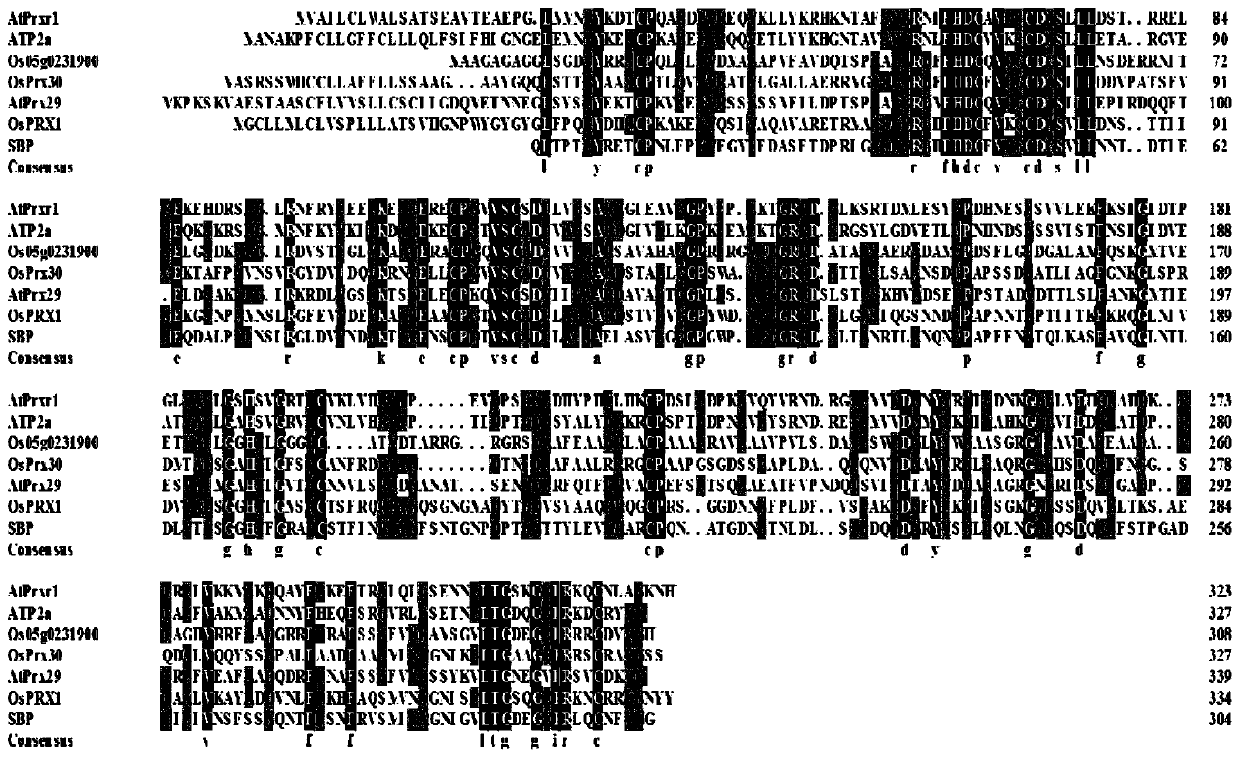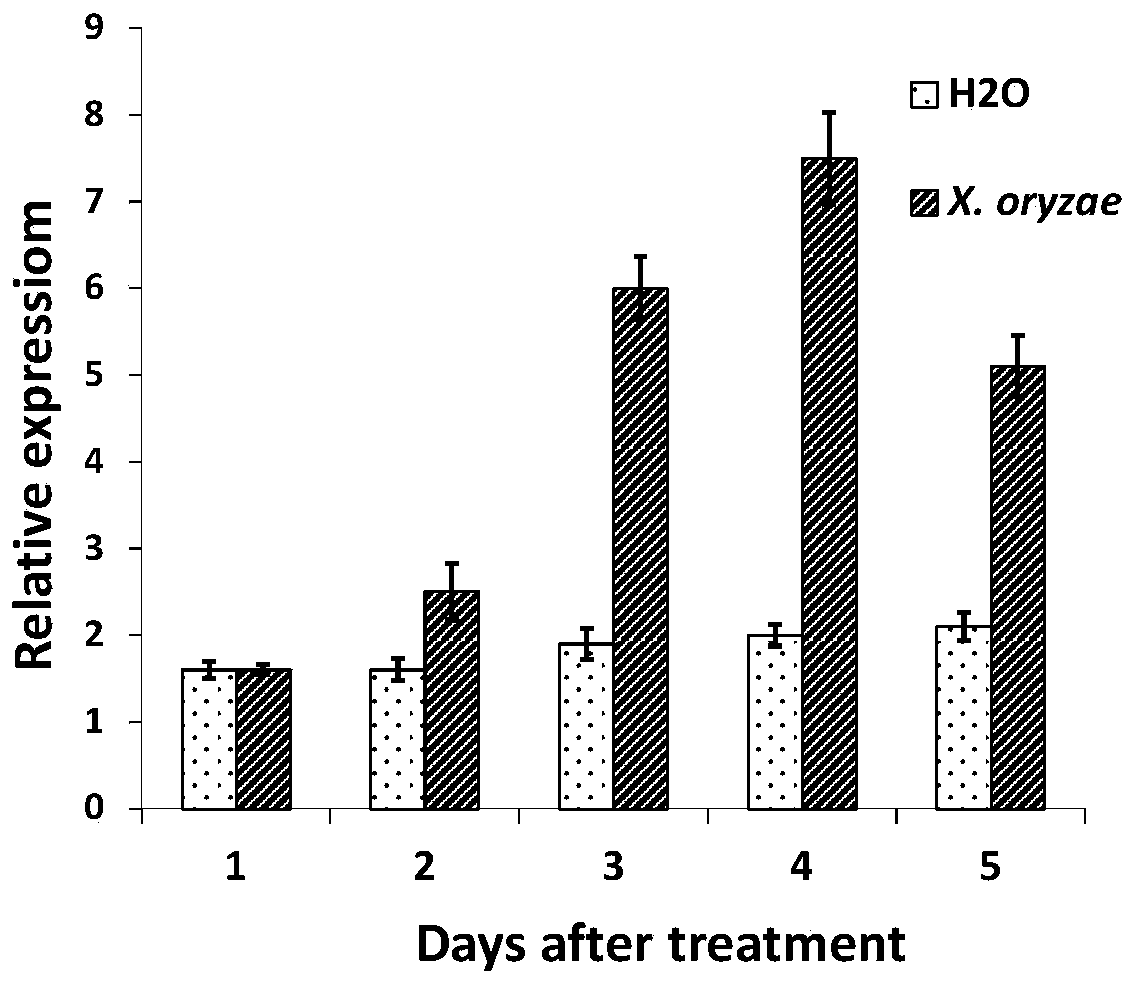Application of gene osprx30 related to bacterial blight resistance
- Summary
- Abstract
- Description
- Claims
- Application Information
AI Technical Summary
Problems solved by technology
Method used
Image
Examples
Embodiment 1
[0029] Example 1 Cloning and sequence analysis of rice OsPRX30 gene
[0030] 1) Extraction of rice total RNA
[0031] Get rice H4 (in literature " rice blast resistance protein Pik 2Cloning of -H4 gene and screening of interacting proteins[J].Guangdong Agricultural Sciences, 2014, (04):156-160.") rice seedlings at the 3-4 leaf stage were frozen in liquid nitrogen and ground into powder, Transfer to a 1.5mL centrifuge tube, and add Trizol reagent (Invitrogen Company) according to the ratio of 1mL extraction reagent per 100mg of material, and mix well; Discard the middle and lower organic phases, collect the upper aqueous phase and transfer to a new centrifuge tube; add 600 μL of isopropanol, mix well, let stand at room temperature for 20 minutes, centrifuge at 12,000 rpm, 4°C for 15 minutes, collect the precipitate, and wait for the isopropanol to volatilize Dissolve in RNase-free ultrapure water and freeze at -80°C for later use.
[0032] 2) Cloning of OsPRX30 gene
[0033...
Embodiment 2
[0039] Example 2 OPRX30 expression trend analysis of different rice after bacterial blight inoculation
[0040] The expression pattern of OsPRX30 gene after inoculation with bacterial blight was analyzed by quantitative RT-PCR. Inoculation of bacterial blight type IV bacteria in H4 (in the literature "Study on the resistance of rice bacterial blight-resistant near-isogenic lines to South China strains [J]. Phytopathological Journal, 2006,36(2):177-180 Disclosed in . ") after different time points (1d, 2d, 3d, 4d, 5d) leaves were collected and total RNA was extracted, and the reverse transcription kit ReverTraAce was used to synthesize the first strand of reverse transcription cDNA. Then, according to the instructions of the SYBR Premix ExTaq kit, the expression level of OsPRX30 was analyzed using the AB StepOne Plus fluorescent quantitative PCR detector, and Actin was used as an internal reference gene.
[0041] The primers and sequences used are:
[0042] OsPRX30-RT-F: 5'-C...
Embodiment 3
[0047] Example 3 Construction of rice OsPRX30 gene editing vector and acquisition of osprx30-ko
[0048] Using CRISPR / Cas9 technology to construct osprx30-ko plants, the specific operation method refers to the method of Ma et al. (2015). The 20bp DNA fragment in the first exon of OsPRX30 was designed to contain the PAM (protospacer-adjacent motif) sequence, and the primers and sequences used were:
[0049] OsPRX30-U3-F: 5'-ggcAACGTCGAGCTCCTCTGCCC-3' (SEQ ID NO: 10);
[0050] OsPRX30-U3-R: 5'-aaacGGGCAGAGGAGCTCGACGT-3' (SEQ ID NO: 11).
[0051] The sequence was fused with the U6a-gRNA expression cassette, and the fused fragment was digested with BsaI and inserted into pYLCRISPR / Cas9P ubi -H carrier ( Figure 4 ) (disclosed in the document "A robust CRISPR / Cas9 System for Convenient, High-efficiency Multiplex Genome Editing in Monocot and Dicot plants. Mol Plant, 2015, 8(8): 1274-84"), construct the transformation vector pYLCRISPR / Cas9P ubi -OsPRX30. This plasmid was transf...
PUM
 Login to View More
Login to View More Abstract
Description
Claims
Application Information
 Login to View More
Login to View More - R&D
- Intellectual Property
- Life Sciences
- Materials
- Tech Scout
- Unparalleled Data Quality
- Higher Quality Content
- 60% Fewer Hallucinations
Browse by: Latest US Patents, China's latest patents, Technical Efficacy Thesaurus, Application Domain, Technology Topic, Popular Technical Reports.
© 2025 PatSnap. All rights reserved.Legal|Privacy policy|Modern Slavery Act Transparency Statement|Sitemap|About US| Contact US: help@patsnap.com



